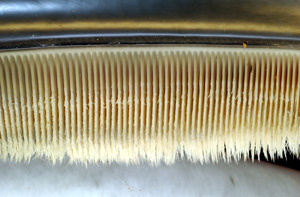
Back Balein Afrikaans بالين Arabic Balina bığı Azerbaijani Кітовы вус Byelorussian Кітовы вус BE-X-OLD Балена Bulgarian Элжэн BXR Barba (balena) Catalan Kostice (kytovci) Czech Barde (hval) Danish



Baleen is a filter-feeding system inside the mouths of baleen whales. To use baleen, the whale first opens its mouth underwater to take in water. The whale then pushes the water out, and animals such as krill are filtered by the baleen and remain as a food source for the whale. Baleen is similar to bristles and consists of keratin, the same substance found in human fingernails, skin and hair. Baleen is a skin derivative. Some whales, such as the bowhead whale, have longer baleen than others. Other whales, such as the gray whale, only use one side of their baleen. These baleen bristles are arranged in plates across the upper jaw of whales.
Depending on the species, a baleen plate can be 0.5 to 3.5 m (1.6 to 11.5 ft) long, and weigh up to 90 kg (200 lb). Its hairy fringes are called baleen hair or whalebone hair. They are also called baleen bristles, which in sei whales are highly calcified, with calcification functioning to increase their stiffness.[1][2] Baleen plates are broader at the gumline (base). The plates have been compared to sieves or Venetian blinds.
As a material for various human uses, baleen is usually called whalebone, which is a misnomer.
- ^ Fudge, Douglas S.; Szewciw, Lawrence J.; Schwalb, Astrid N. (2009). "Morphology and Development of Blue Whale Baleen: An Annotated Translation of Tycho Tullberg's Classic 1883 Paper" (PDF). Aquatic Mammals. 35 (2): 226–52. doi:10.1578/AM.35.2.2009.226.
- ^ Szewciw, L. J.; De Kerckhove, D. G.; Grime, G. W.; Fudge, D. S. (2010). "Calcification provides mechanical reinforcement to whale baleen -keratin" (PDF). Proceedings of the Royal Society B: Biological Sciences. 277 (1694): 2597–605. doi:10.1098/rspb.2010.0399. PMC 2982044. PMID 20392736. Archived from the original (PDF) on 2011-12-25.